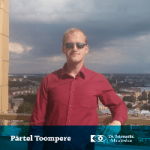20 016 968
Eye laser surgery
After years of constant research, eye doctors and engineers have recently found the solution how to return clear vision to people, who suffer from vision deterioration; without doing away with the need for eyeglasses or contact lenses. The technology was named LASIK (stands for Laser – Assisted In Situ Keratomileusis). Very soon after it’s development, it garnered the trust and popularity of eye doctors and their patients because of its rapid effect, high success rate and stable results, and a quick rehabilitation period. Today, Laser Eye Surgery is one of the most common elective surgical procedures in the world, with over 1 million patients undergoing this vision correction treatment every year in America alone.
Since 1999, when we first established laser eye surgery in the Baltic region, thousands of patients have acquired a completely new life quality without dependence on eyeglasses or contact lenses.
Lasik is an outpatient procedure that is intended to reduce the person’s dependency on glasses or contact lenses. The actual procedure takes only a few minutes, is relatively painless, and allows the patient to get back to their everyday routine, such as working and driving, usually by the next day. Using a laser, such vision problems as nearsightedness (myopia), farsightedness (hyperopia) and astigmatism can be successfully corrected. During the surgery the shape of the cornea, the clear covering of the front of the eye, is permanently changed using an excimer laser. The cornea works in the same way as the lens of a camera that focuses light to create an image on film. Imperfections in the focusing power of the eye, that are concentrated mainly in cornea, are called refractive errors. In this case, the image on the retina is out of focus, and the aim of the Lasik procedure is to return the image to normality upon the retina by correcting the imperfections of the cornea surface.
A special instrument, called a microkeratome, is used to cut a flap in the cornea. The flap is followed back revealing the stroma, the mid-section of the cornea. Pulses from a computer-controlled laser vaporize a portion of stroma creating a new refractive surface that is programmed individually for the patient. Then the flap is replaced. There is no sutures needed, there is no blood and no pain during the operation. Almost immediately after the operation the patient can find his vision significantly improved (although it may take several hours), achieving maximal stable results after 3 months. During the rehabilitation period there are almost no limitations for living an active lifestyle.
If the patient for some reason IS NOT A GOOD CANDIDATE for a laser eye surgery, IT DOES NOT MEAN that there is no way to reduce or eliminate the use of eyeglass dependence. Our clinic provides surgical alternatives of acquiring a clear vision – the implantation of phacic lenses (ICL or Implantable Contact Lenses). ICL’s are, in fact, a great opportunity for those who are not ideal candidates for LASIK.
- Vision improvement immediately after the surgery
- Anaesthetic eye drops provide excellent comfort during the treatment
- Get freedom from glasses and contact lenses!

Answers and questions
Femtolasers work in infrared spectrum, and produce ultra short impulses. One femtosecond is 10-15 of a second. This type of lasers provides maximal control for the surgeon and maximal comfort for the patient. Femtosecond lasers are used: In laser eye surgery to prepare a cornea for the laser surgery (corneal flap creation in FemtoLASIK method) In laser eye surgery to perform the FLEx method In corneal transplantation surgeries To implant intracorneal segments
Traditionally, performing classical LASIK surgery, the surgeon prepares cornea for laser eye surgery with a special instrument called microkeratome. The surgeon creates a thin superficial corneal incision and forms a corneal flap. Then excimer laser starts its work and corrects the vision problems. Finally the flap is returned back to its place and the surgery complete. Using this technique, instead of making an incision with a microkeratome, another laser is used, called femtosecond laser. It is more precise, safe, and provides maximal comfort for the patient. The femtosecond laser is also used for corneal transplantations, keratoconus treatment and other purposes. Advantages that patient receives from the new technology: Minimal risk of complications High precision of laser treatment Maximal patient satisfaction with results Method can be applied on thin corneas and higher diopters
In May 2009, a new laser center that equipped with modern femtosecond and excimer superlasers was introduced by our Clinic. The femtosecond technology introduced new standards for laser eye surgery, presenting the highest level of precision, safety and stability. Femtosecond laser VisuMax:
The VISUMAX system is designed to provide smooth and precise flap cutting capabilities for refractive laser surgery. This technology, combined with MEL 80 excimer laser, delivers excellent clinical outcomes coupled with the potential for a unique optimized workflow for refractive surgeons and improved comfort for their patients. Moreover, VISUMAX is the only laser system in the world that is able to perform FLEx procedure – the latest innovation by Carl Zeiss Meditec that provides new possibilities in laser eye surgery. The VISUMAX was certified by FDA to perform FemtoLASIK in 2007.
Excimer laser Mel 90:
One of the best excimer lasers in the world. High frequency laser performs both standard and personalized laser eye surgery programs. It is used in surgical and therapeutic purposes, both individually (LASIK procedures) and together with VisuMax laser, performing FemtoLASIK procedures.
We offer all available methods of laser eye surgery:
FemtoLASIK;
FLEx;
LASIK;
EpiLASIK;
LASEK;
PRK.
FLEx (Femtosecond Lenticule Extraction)
A standard laser eye surgery consists of two main steps: first, the surgeon prepares the corneal surface for the optical correction. It is done either mechanically, using a special instrument called microkeratome or using a laser beam, that creates the necessary surface for the optical correction. Then the laser is applied to correct the refractive error, and the latest technologies, called the FLEx method, allows performing the surgery in only one step. The laser that operates in our Centre is the only laser in the world that combines the power of two lasers in one, so there is no need of any laser combination. It is convenient for the patient, safe, provides quick recovery and perfect results.
Testimonials
-

Olegs Č.
I would highly recommend your clinic to everyone!
-

Aivi R.
-

Pärtel Toompere
It was very positive that the surgery didn't interrupt my daily life the next days.
-

Käroli Michelson
The next morning the world was clear, my eyes didn't hurt and the eyesight was clear.
-

Liisi Värv
Laser eye surgery was one of the best investments I've made! The people there were friendly sweet and kind. The service was super!
-

Kaspars U.
After almost 20 years I see without glasses again. Now, from time to time, I imagine why I didn't do it faster.
-

Liene J.
Can life change after eye laser correction? YES, it can!
-

Evita A.
Right now, two weeks have passed since the surgery and I see perfectly well. Happier and without GLASSES!
-

Ilva Ž.
These are fantastic feelings. I have only one question, why didn't I do it before?!
-

Jevgenijs R.
I'm completely satisfied with the results after SuperLasik surgery. The staff at the eye centre was very interested to explain all the necessary information about the vision correction surgery.
Our clinic offers diagnostics and treatment services
Laser vision correction
The price is for both eyes depending on the correction method
Lasek1200,-€ |
FEMTO-Lasik2020,-€ |
Lasik1200,-€ |
Presbyond2700,-€ |
EPI-Lasik1500,-€ |
SMILE (ReLEx)3000,-€ |
SuperLasik1710,-€ |
Lasik Xtra3000,-€ |
Complicated vision correction1300,-€ |
Reoperation750 EUR – (free within 1 year) |
Laser vision correction by replacing lenses with multifocal optical implants using a femtosecond laserfrom 1755,-€ per one eye |
Laser vision correction using ICL optical implantsfrom 2200,-€ per one eye |
Laser vision correction methods and their comparison
Our clinic offers diagnostics and treatment services